
Recently I wrote an article about Tokitae (Lovely Lolita), a juvenile orca abducted from her family in the early 1970’s off the coast of Washington State. As I worked through her capture and transfer to life in a marine park I realised that her story was too big a task to do justice at that time. So now I begin again to broach the subject. I intend to condense into a single article what really could fill a book. Unfortunately, you probably know this orca by her captive name, Lolita.
Lolita lives at Miami Seaquarium. She has lived there since she was captured over forty years ago. She was trained to perform and still does so on a daily basis. Her story is one of complexity. For one, there is no like for like comparison in the history of orca captivities. Although, the story of release to freedom for Keiko (Free Willy) does hold some similarity and hope. Secondly, emotions run high from an anti-captivity view-point versus a pro-captivity view-point. Both groups asserting to know what is best and right for Lolita, both with entirely different stances on her current existence and that of her future. Thirdly are the unseen forces at work. Although Lolita ‘belongs’ in the great wide ocean she is ‘owned’ by a business corporation, an industry. I will tackle the institution of “marine parks” and “aquariums” in a separate article! I believe that Lolitas capture and successive captivity were, and are, both unethical and immoral. However, the fact remains that her current situation is a life of captivity, so that is what I will focus on. What really is best for Lolita?
Lolita is housed in a tank at Miami Seaquarium (MSQ), the size of which violates Animal Planet Health Inspection Service’s (APHIS) standards for minimal requirements. Without taking the gradienting walls in to account, the width is 80′ at its maximum, the equivalent of an average 25m leisure centre / hotel swimming pool. Lolita is approximately 21′ long (6.4m). Therefore, her maximum capacity of travel is a distance of a mere 3.8 times her own body length in one direction or 1.7 times her length in the other direction, a width of 35′(10m). The depth of her pool is 20′, one foot less than her own length.

(Image courtesy of savelolita.org)
Based on the average UK adult height of 5’6″ (168cm) this is the equivalent of being confined to a living room 20’6″x8’3″ (6.4×2.5m) with a ceiling height of 5’3″ (160cm). All day, every day. Please take a moment to comprehend this, and lets not forget the cold ready meals everyday too.

Orcas can travel 75-100 miles per day. To achieve 1 single mile Lolita would have to swim 66 laps of her tank, 75 miles would take 4950 laps. Orcas can dive hundreds of feet, Lolita can’t even touch the bottom of her tank with her nose, vertically, and remain fully submerged. This alone illustrates a cruel confined existence that defies belief and yet there’s more, much more.
MSQ has reportedly been promising a larger tank since 1976. Both APHIS and MSQ have failed to respond to my queries relating to these claims, therefore I am left to assume I already have the correct information. The United States Department of Agriculture (USDA) webpage to access Tank Regulations is no longer accessible (at least not that I’ve been able to find) and no response has been received by me regarding my request to have them emailed instead.
I aim to address some common pro-captivity arguments about the proposed release of Lolita. Such as, argument 1, ‘Lolita being captive for a number of decades is, obviously, unfamiliar with the ocean. This change could cause her a lot of stress and potentially risk her life.’ I find it exceedingly hard to contrive that the same mindset of people who had Lolita effectively kidnapped from her family amidst the most stressful, confusing and unlikely circumstances she would ever encounter in her life argue that returning her to the ocean could cause fatal stress. On a daily basis she is subjected to stresses with no place to run or hide. “They (orca) use a type of natural sonar called Echolocation, to navigate in the water and to locate objects. Living in a concrete pool is torture for an animal that uses this type of heightened sense, as their sound waves bounce off of the walls in the concrete tank, which is believed to cause stress to the animal.” Exert from Save Lolita. [1]
After Lolita’s brutal abduction from her family not long after infancy, bearing in mind she would have naturally stayed with her mother for her entire life, she witnessed the death and loss of her ex-tank-mate Hugo. Who’s corpse was disposed of on a tip. She has lived in solitude of her own kind ever since, her calls are never answered but reverberate around her concrete tank, she has no real space, nor real companionship. Her existence is based on a relationship of performing tricks amidst noise and crowds of people, for her food – but not shelter because that isn’t afforded her. To name but a few issues, and yet, ‘returning her to the ocean could cause stress’. Fail.
Argument 2, ‘Lolita can’t be taught how to use her sonar and thus avoid boats.’ Her sonar is already functional. I think if she is able to navigate her whale bowl without bouncing off the sides at every turn she can probably avoid a boat in the expanse of ocean. Initially she will be kept from harms way and eventually she would hopefully be amongst a large family pod, who would hone her sonar and boat-dodging techniques.
Argument 3, ‘Lolita doesn’t know how to hunt for herself, she has trust in humans and has been reliant on trainers and vets since 1970.’ This support and trust will remain to be encompassed in her rehabilitation project. She could relearn hunting skills and will be fed for as long as is required to supplement her diet.
Argument 4, ‘even if moved to a sea pen she will still be captive and dependant on human care.’ Not really! Technically she will be held in a confined area for her own safety and as part of her rehabilitation journey. As and when she is deemed ready, her confines will be broadened to allow Lolita to explore further afield at her desire. Entirely unlike the captivity she knows at MSQ, with her unrelenting concrete confines, where she performs her merciless daily rituals and routines for her fishy diet, effectively “singing for her supper”. Captivity as defined by Wikipedia is “the state of being confined to a space from which it is difficult or impossible to escape”. So not at all like her proposed sea pen. Lolita’s dependence on humans will be at her discretion and based on supporting her transition to independence, as opposed to a tool for moulding her behaviour to one of reliance. Some will contend that no marine mammal is forced to perform, that they are fed regardless of the behaviour that they exhibit. Others conversely will confide that the withholding of food sources is indeed used to entice the desired behaviours of captives. Whether food is withheld or not Lolita, and indeed any other performing marine mammal, do not “choose” to perform, they do so as part of a learned behaviour, their conditioning.
“Classical conditioning .. is a form of learning in which the conditioned stimulus or CS, comes to signal the occurrence of a second stimulus, the unconditioned stimulus or US. (A stimulus is a factor that causes a response in an organism.) The conditioned response is the learned response to the previously neutral stimulus. The US is usually a biologically significant stimulus such as food or pain that elicits a response from the start; this is called the unconditioned response or UR. The CS usually produces no particular response at first, but after conditioning it elicits the conditioned response or CR. Classical conditioning differs from operant or instrumental conditioning, in which behavior emitted by the subject is strengthened or weakened by its consequences (i.e. reward or punishment).” Wikipedia [3]

(Image by Peter Pijpelink, courtesy of Orca Network)
A retirement plan for Lolita proposed by the Orca Network would place her in a transitional coastal sea pen sanctuary in her native waters, where she would be rehabilitated under human care, then given the choice to go back to open waters if it’s deemed safe. When asked to comment Howard Garrett of Orca Network had this to say “I would like everyone to know that our proposal to return Lolita to her native waters in a netted off bay for rehab and long-term retirement has been vetted by veteran cetologists and can be done safely. She would be provided the same quality of care and provisioning she now receives. There is no part of the transportation or introduction process that involve any real risk to her. Lolita, who we’ll call Tokitae whenever she comes home, has proven she is extremely courageous and strong, and would respond positively to the reintroduction to her home, with the opportunity to communicate with her family.” The full retirement proposal can be viewed on the Orca Network website.
Lolita’s natural family, “the southern residents”, are one of the most studied groups of killer whales in the world. It is believed her birth mother is possibly one of two orca still alive from the time of the Puget Sound captures. She has one of the most researched histories and therefore one of the best chances of successful rehab and release to date. Lets face it, this is what scares the captivity industry the most. This is their gravest concern. If Lolita is retired to a natural environment as proposed, and all goes to plan, she will have set a precedent that will undoubtably set animal advocates calling for the release of many more marine mammals world-wide.
The thing about freeing Lolita is, no one has proposed to drop her back into the ocean and wish her well as she’s left to her own devices. No one is proposing that she be removed from one environment to another more detrimental to her well-being. Lolitas freedom is more about giving her back the chance, the right, of a natural, normal environment after a lifetime of servitude. It may well end in devastation, but no more so than to die alone in a fish bowl after years of abusive performing, to be discarded on the local dump. Otherwise, all being well, Lolita will go on to become an enigma to captive marine life world-wide. She will have chances that could only be dreamed of in her current captivity. The chance to re-establish relationships and swim once again with the family she was so tragically torn from as an infant, a chance to navigate depths she barely knew possible, a chance of producing her own young, a chance of living a life of an orca, life as it should be, a life that knows no bounds. Under Lolitas current situation it is plausible to suggest that she suffers physical, social, and mental constraints. Under her retirement proposal said constraints would be lifted. To Miami Seaquarium Lolita is no more than a commodity. But she is more, much more. Free Lolita.

Image courtesy of Free Lolita
Filmmaker Daniel Azarian connects people on a human level to the plight of Lolita in this 90 second Public Service Announcement (PSA) which highlights the similarities between humans and orcas: high-intelligence, close family groups, and intense sociability. [2] Courtesy of Savelolita.org
Images used with prior permission where possible, with thanks. No known breach of copyrights intended.
http://savelolita.org/her-story-2 [1]
http://news.mongabay.com/2013/0122-hance-lolita.html [2]
http://en.wikipedia.org/wiki/Classical_conditioning [3]
Very informative and educational…thank you.
Give her the chance to be free.
In submitting my comments to NOAA, have copied segments of this great article on the release of Lolita. Please accept my sincere thanks for your work here. My submission purely refers to what I have copied by quotes & you as the identified source.
.
That’s very kind, glad to have been of assistance! – Thank you.
You see you can and do make a difference no matter how small or large you are doing a great job…so proud of you ….Px